Tala Lasi Samoa(1)
Fatu Feu'u, Painter of Tales
PANDORA FULIMANO PEREIRA
Fatu Feu'u, the noted New Zealand-based Samoan artist, speaks of Samoan art with authority: Interpretations? There are many many different interpretations of symbols. In Samoa for example, every village involved with the legend of Lupe Ulu Iva [The Nine Headed Pigeon](2) has a different perspective. The gist, the essence of the tale is there, but the detail changes in the different places. Like in Samoan oratory, or any historic event or occurrence, one village interprets it in one way and the next village interprets it another. Tala lasi Samoa is the Samoan way of telling stories, with multiple meanings on multiple levels. There is another saying, 'e lasilasi Ie aso', which we are going to do. That is, today we are going to exchange a few stories to entertain ourselves.
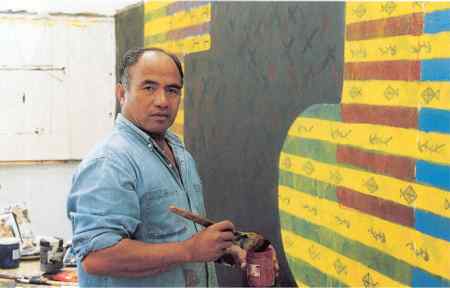
Fatu Feu'u in his studio, Auckland 2004 (photograph: Rebecca Steedman)
Two categories of chiefly titles exist within the Samoan matai (appointed heads of kin groups) system, one is ali'i, chief, the other tulafale, orator. Ali'i are 'sacred' chiefs as it were, genealogically linked to the gods, and ultimately to he who was first, Tagaloaa-lagi. Respected elders of the extended family, ali'i are the ultimate authority regarding all property and resources of their respective families. Their carriage and behaviour are a reflection on all those they represent. Tulafale on the other hand are the 'secular' chiefs, chosen advisers and the voice of ali'i. In practice however, the tulafale role cannot be so easily dismissed. Tulafale are potentially extremely influential, their power base the individuals' knowledge of Samoan history, traditions and genealogy, and the ability of those individuals to articulate and wield that knowledge.
Fatu Feu'u holds both an ali'i title and a tulafale title. Feu'u has the orator title of Si'a, bestowed by his father's family, of the village of Potasi, and the ali'i title of Lesa, bestowed by his mother's family, of the village of Sa'anapu.
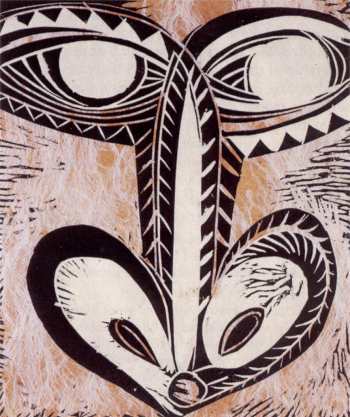
FATU FEU'U Orongo 1992 Woodblock on barkcloth, laid on paper, 596 x 490 mm. (Collection of Auckland Art Gallery Toi o Tamaki)
As a binary pair, these titled roles manifest traditional Samoan ideals of balance, sacred / secular, inactive / active, dignified / aggressive and so forth. A duality can be perceived in the roles Feu'u has within the Samoan cultural context, as both chief and orator, and that which he has carved out for himself within the New Zealand artistic context, as an artist and educator.
In the true egalitarian ethic at the heart of Polynesia, one may be addressed as ali'i upon reaching a certain age. But beyond this respect for age and formal title, Feu'u has earned kudos through sheer hard work and diligence. Giving much of himself and his energy, Feu'u makes himself available to all - journalists, educationalists, tertiary students, young artists and school children - equally.
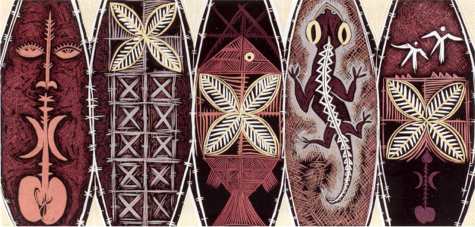
FATU FEU'U Vi'iga poula: Adoration of Fertility Ritual by Night 2001 Woodcut, 559 x 1212 mm. (Collection of Auckland Art Gallery Toi o Tamaki)
Recognised as the elder statesman of Pacific art, Feu'u takes this role seriously and uses it to advance Pacific art and artists. His involvement with the New Zealand Medallion Group, is one such example. Membership of this small and select body of artists was an exciting prospect, offering Feu'u the opportunity to explore what for him, was a new medium. But perhaps more enlightening has been the experience of curating their 2001 group show Pacific Rim - Te Pae O Te Moananui A Kiwa. Used to working in larger formats, Feu'u was confronted not only with the rigid set of dimensional specifications, but also with a cross-cultural situation he had not expected. There were no Maori, none of us, and well I thought to myself that this is my chance. I have to put my foot in the door, if you like, of this elite society, and get other Pacific people involved. It was funny, the Europeans gave us a set of instructions. They set out the size, thickness, width and all that. I thought, 'Shit! No way. I don't' want to be dictated to in that way about the making of art.' I guess there were different sets of values. We argued things through, and agreed to some compromises. Terry Stringer was a big help to me. He said, 'We're in the Pacific now,' and I thought that was very good of him. We agreed to do things the Pacific way. The Pacific way is a bit more democratic. But it was a good learning experience.(4)
The show toured around the country, showed in London, and opens in New York later this year.

FATU FEU'U Fa'aisifoga 2001 Acrylic on canvas, 830 x 1100 mm. (Private collection, Auckland)
As custodians of culture and history in Samoan society, tulafale employ allusion, myth and imagery, they plumb Samoan history for symbolism and allegoric metaphor in the delivery of truly great speeches. Just as a tulafale's knowledge and power finds full expression in oratory, Feu'u too utilises myth and metaphor in the creation of works here in New Zealand. Fa'aSamoa, the Samoan way, is his frame of reference, his graphic vocabulary a cache of Samoan, and increasingly pan-Pacific, stylistic patterns and abstract designs. Reinforcing the duality of the roles he fulfils within the two countries he refers to as home.
A pragmatist at heart, Feu'u laughingly admits the additional names that come with the respective titles can be problematic. 'My family have asked me to sign works using my titles, but commercially it is difficult. You would end up with your title name or names, the family name, your own name. You'll end up with a whole string of names across the bottom of the works, and people will think "what the hell is going on here?"'(5) On the other hand, deeply moved by the recognition of his 'aiga (extended family), the full weight of the responsibility is certainly not lost on Feu'u.

FATU FEU'U Ulu Malauli 1999 woodcut, 945 x 350 mm.
I feel very humble and honoured to have these titles bestowed on me . . . for my family to recognise me with these titles is a great personal honour. In Samoan oratory if you don't think so deeply about your chosen words at a chosen moment, you could lose a life. Like in ifoga.(6) The paramount chief, the ali'i, carries out ifoga on behalf of the perpetrator. The paramount chief, plus all the other chiefs and senior members of the 'aiga, they are the ones to go and sit under the 'ie toga (fine mat).(7) People have said that ifoga is cowardly. But in the days before, you could be killed. Your paramount chief could have been killed. Is that cowardly? That is what you're accepting as part of your role, when you take a title, you have to look after your family to the death.(8)
In speaking about his art practice, Feu'u asserts an intention to mediate an understanding of Samoan culture and history. What is equally apparent is that Samoan culture is the filter through which Feu'u interprets all that is around him. From national issues of race relations in New Zealand, and international conservation concerns, to very personal themes of a child's struggles and personal estrangements, all are worked through a very Samoan worldview.
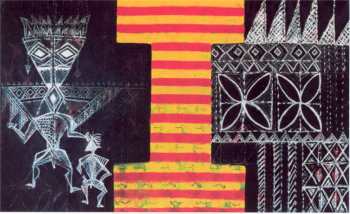
FATU FEU'U Vai Manino 2004 acrylic and oil stick on canvas, 2420 x 1520 mm.
Early in his career Feu'u looked to the likes of Picasso and Gauguin for artistic inspiration. The well-documented chance meeting with Tony Fomison in the early 1980s helped him redirect his attention, and focus much more directly on what he already knew and loved-Samoan culture and traditions. It is a rich vein, which Feu'u has mined to great effect over the intervening years.
Cultural values of balance, symmetry, exchange and reciprocity informed ancient designs, repetition of which remain and continue to be incorporated into Pacific tapa and tattoo. Many of these patterns find new expression in the works of Feu'u, and to these ancient insights, he adds his own personal meanings and metaphors. His iconography is an amalgam of graphic patterns from siapo, tapa-making and tatau, tattoo; stylised elements such as frangipani, gogo, tern, anufe, caterpillar; and objects of evident symbolic potential, hand prints, paddles, scales. To this mix he adds elements of personal symbolism, of which the Lapita 'mask' stands out as a striking example.
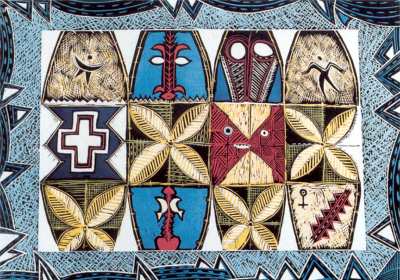
FATU FEU'U Tamilo I Moana 2004 woodcut, 760 x 1070 mm.
Much has been made of the use of the mask motif in Feu'u's.work. The 'mask' face appeared on a 'new' form of decorated pottery found in island Melanesia, and is material evidence of a people who emerged from the west, and who would over the coming centuries discover and settle the islands of the Pacific, and develop a Polynesian culture in the area of Tonga, Fiji and Samoa, 'the cradle of Polynesia'.
Contrary to the Samoan view of an autochthonous origin, this 'new' find points to a tradition of migration. The meaning and significance of the face is now unknown, however Feu'u has claimed this 'mask' for his repertoire of design elements and in navigating the disparate Samoan and western worldviews, the 'mask' has become symbolic of the quintessential spiritual ancestor, and the spiritual dimension.
In the same way a studious and diligent tulafale will consult and seek the counsel of respected and knowledgeable elders. Feu'u regularly returns home to Samoa to refresh his memory, inhale the smell of home, and also to consult with elders of his 'aiga and village. Over the years Feu'u has also struck up other kinds of collaborative relationships. He has had many years' association with the 'old man' of Pacific archaeology himself, Auckland University Professor Roger Green, who 'unearthed' the potsherd with the stylised human face during research in Santa Cruz. Theirs has been a reciprocal exchange of knowledge; at times the teacher becomes the pupil and the pupil the teacher.
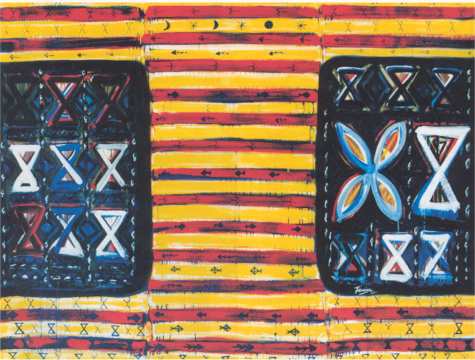
FATU FEU'U Vai Tupu 2004 acrylic and oil stick on canvas, 1960 x 1520 mm.
Represented in public and private collections all over the country, Feu'u has been commissioned for works throughout the Pacific and has works in museums and art galleries in New Caledonia, Australia, New York and Germany. As the consummate salesman Feu'u has accomplished a certain level of commercial success. Indeed it is difficult to find a more patent example of aptitude, perseverance and hard work resulting in 'living the dream', thus making Feu'u a tremendous role model for young Pacific islanders exploring a career in the visual arts.
Over the last five years reconciliation has been Feu'u's thematic preoccupation, and ifoga the sub-text of an on-going series of works. In this most Samoan of rituals, Feu'u finds possibilities and lessons to mediate an as yet unknowable resolution to the current issues regarding New Zealand's foreshore and seabed. Our 'paramount chief' has on various occasions offered formal apology in her capacity as the head of this country. But the ultimate act of contrition is highly unlikely.
Sometimes dismissed as too accessible, stereotypical and ubiquitous, Feu'u's works have undeniably struck a chord; non-confrontational and sincere they offer a Pacific accent to a still largely self-conscious New Zealand, but one that is aware of its place in the Pacific. Feu'u has also been criticised for the range of media he uses. For this he is unapologetic, and seems genuinely baffled that he should even entertain the idea of restricting himself. An understanding of our Pacific culture comes out of the arts, it helps bridge the gaps between cultures. It helps them understand the values of Pacific people. Without being dogmatic about it, I enjoy all art forms, whether it's printmaking, sculpting, painting. I do them all because I enjoy all visual art forms. I've asked journalists if it is a problem and they say artists should stick to one art form. Yes, I have made pots with Barry Brickell, and designed rugs with Kate Wells, and done glass, and have gone into bronze casting. But I feel I'm lucky that I can express myself in visual arts forms. I can't make films like Peter Jackson. I'm not good at writing, so can't publish books. But I have so many things inside me to express. I'm not good at writing poetry, all my poetry is in my art.(9)
1. Tala lasi Samoa refers to the multiplicity of meanings within Samoan narratives. 2. See Gwen Stacey 'The Art of Fatu Feu'u', Art New Zealand 45. Winter 1988, pp. 48-51, for a good introduction to this artist's work. 3. Interview with the author, 2004. 4. Interview with the author, 2004. 5. Interview with the author, 2004. 6. Act of ritual apology. 7. In the pre-dawn light the ali'i and his entourage of other titled heads of the family, will arrive at the family home of the wronged party. In public they will sit cross-legged beneath a fine mat to await the will of the victims family. 8. Interview with the author, 2004. 9. Interview with the author, 2004.
